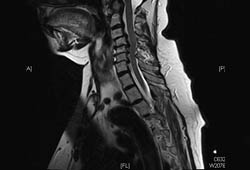Cervical spondylosis incidence varies with age. Population-based magnetic resonance imaging (MRI) studies show nearly 100% of adults aged >40 years have severe degeneration of at least 1 cervical level (commonly C5/6).[1]Matsumoto M, Fujimura Y, Suzuki N, et al. MRI of cervical intervertebral discs in asymptomatic subjects. J Bone Joint Surg Br. 1998 Jan;80(1):19-24.
https://online.boneandjoint.org.uk/doi/pdf/10.1302/0301-620X.80B1.0800019
http://www.ncbi.nlm.nih.gov/pubmed/9460946?tool=bestpractice.com
[2]Guzman J, Haldeman S, Carroll LJ, et al. Clinical practice implications of the Bone and Joint Decade 2000-2010 Task Force on Neck Pain and Its Associated Disorders: from concepts and findings to recommendations. J Manipulative Physiol Ther. 2009 Feb;32(2 suppl):S227-43.
http://www.ncbi.nlm.nih.gov/pubmed/19251069?tool=bestpractice.com
[3]Braga-Baiak A, Shah A, Pietrobon R, et al. Intra- and inter-observer reliability of MRI examination of intervertebral disc abnormalities in patients with cervical myelopathy. Eur J Radiol. 2008 Jan;65(1):91-8.
http://www.ncbi.nlm.nih.gov/pubmed/17532165?tool=bestpractice.com
[4]Siivola SM, Levoska S, Tervonen O, et al. MRI changes of cervical spine in asymptomatic and symptomatic young adults. Eur Spine J. 2002 Aug;11(4):358-63.
http://www.ncbi.nlm.nih.gov/pubmed/12193998?tool=bestpractice.com
[5]American College of Radiology. ACR appropriateness criteria: cervical neck pain or cervical radiculopathy. 2018 [internet publication].
https://acsearch.acr.org/docs/69426/Narrative
[6]Binder AI. Neck pain. BMJ Clin Evid. 2008 [internet publication].
https://www.ncbi.nlm.nih.gov/pmc/articles/PMC2907992
http://www.ncbi.nlm.nih.gov/pubmed/19445809?tool=bestpractice.com
However, only a subset of patients present with axial neck pain, and patients are usually asymptomatic even though cervical radiographs and MRI may show severe, spontaneous degenerative disease.[4]Siivola SM, Levoska S, Tervonen O, et al. MRI changes of cervical spine in asymptomatic and symptomatic young adults. Eur Spine J. 2002 Aug;11(4):358-63.
http://www.ncbi.nlm.nih.gov/pubmed/12193998?tool=bestpractice.com
[7]Binder AI. Cervical spondylosis and neck pain. BMJ. 2007 Mar 10;334(7592):527-31.
http://www.ncbi.nlm.nih.gov/pubmed/17347239?tool=bestpractice.com
[8]Kovalova I, Kerkovsky M, Kadanka Z, et al. Prevalence and imaging characteristics of nonmyelopathic and myelopathic spondylotic cervical cord compression. Spine (Phila Pa 1976). 2016 Dec 15;41(24):1908-16.
http://www.ncbi.nlm.nih.gov/pubmed/27509189?tool=bestpractice.com
[Figure caption and citation for the preceding image starts]: Severe, multilevel degenerative disk disease changes but without significant spinal cord compression (i.e., neither deformation nor intrinsic T2 changes) on cervical MRI (sagittal T2)Dennis A. Turner, MA, MD [Citation ends].
The estimated incidence of degenerative cervical myelopathy is at least 41 per million people in North America.[9]Nouri A, Tetreault L, Singh A, et al. Degenerative cervical myelopathy: epidemiology, genetics, and pathogenesis. Spine (Phila Pa 1976). 2015 Jun 15;40(12):E675-93.
http://www.ncbi.nlm.nih.gov/pubmed/25839387?tool=bestpractice.com
In one study, 59% of individuals ages >40 years had signs of cervical cord compression on MRI.[8]Kovalova I, Kerkovsky M, Kadanka Z, et al. Prevalence and imaging characteristics of nonmyelopathic and myelopathic spondylotic cervical cord compression. Spine (Phila Pa 1976). 2016 Dec 15;41(24):1908-16.
http://www.ncbi.nlm.nih.gov/pubmed/27509189?tool=bestpractice.com
However, only 1% to 2% of patients with cervical spondylosis proceed to surgical intervention, as nonoperative treatments suffice in most patients.[10]Matz PG. Does nonoperative management play a role in the treatment of cervical spondylotic myelopathy? Spine J. 2006 Nov-Dec;6(6 suppl):175S-81S.
http://www.ncbi.nlm.nih.gov/pubmed/17097536?tool=bestpractice.com
[11]Mazanec D, Reddy A. Medical management of cervical spondylosis. Neurosurgery. 2007 Jan;60(1 suppl 1):S43-50.
http://www.ncbi.nlm.nih.gov/pubmed/17204885?tool=bestpractice.com
[12]Patil PG, Turner DA, Pietrobon R. National trends in surgical procedures for degenerative cervical spine disease: 1990-2000. Neurosurgery. 2005 Oct;57(4):753-8.
http://www.ncbi.nlm.nih.gov/pubmed/16239888?tool=bestpractice.com
[13]Rao RD, Gourab K, David KS. Operative treatment of cervical spondylotic myelopathy. J Bone Surg Am. 2006 Jul;88(7):1619-40.
http://www.ncbi.nlm.nih.gov/pubmed/16818991?tool=bestpractice.com
[14]Salt E, Wright C, Kelly S, Dean A. A systematic literature review on the effectiveness of non-invasive therapy for cervicobrachial pain. Man Ther. 2011 Feb;16(1):53-65.
http://www.ncbi.nlm.nih.gov/pubmed/21075037?tool=bestpractice.com
The incidence of cervical spine radiculopathy ranged from 0.832 to 1.79 per 1000 in one systematic review.[15]Mansfield M, Smith T, Spahr N, et al. Cervical spine radiculopathy epidemiology: a systematic review. Musculoskeletal Care. 2020 Dec;18(4):555-67.
http://www.ncbi.nlm.nih.gov/pubmed/32710604?tool=bestpractice.com
